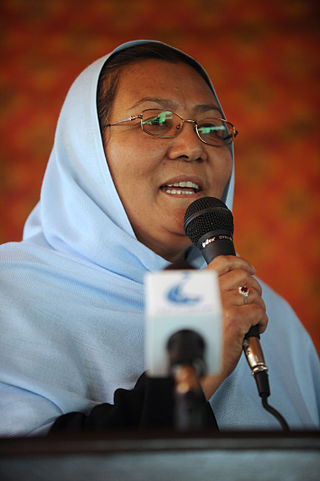Barik-e Sofla | |
|---|---|
| Coordinates: 34°22′N66°39′E / 34.367°N 66.650°E | |
| Country | |
| Province | Bamyan Province |
| Time zone | + 4.30 |
Barik-e Sofla is a village in Bamyan Province in northern-central Afghanistan. [1]
Barik-e Sofla | |
|---|---|
| Coordinates: 34°22′N66°39′E / 34.367°N 66.650°E | |
| Country | |
| Province | Bamyan Province |
| Time zone | + 4.30 |
Barik-e Sofla is a village in Bamyan Province in northern-central Afghanistan. [1]

Afghanistan is divided into 34 provinces. The provinces of Afghanistan are the primary administrative divisions. Each province encompasses a number of districts or usually over 1,000 villages.

Bamyan Province, also spelled Bamiyan, Bāmīān or Bāmyān, is one of the thirty-four provinces of Afghanistan with the city of Bamyan as its center, located in central parts of Afghanistan.

Bamyan, also spelled Bamiyan or Bamian, is the capital of Bamyan Province in central Afghanistan. Its population of approximately 70,000 people makes it the largest city in Hazarajat. Bamyan is at an altitude of about 8,366 feet (2,550 m) above sea level. The Bamyan Airport is located in the middle of the city. The driving distance between Bamyan and Kabul in the southeast is approximately 180 kilometres (110 mi). The Band-e-Amir National Park is to the west, about a half-hour drive from the city of Bamyan.

Dr. Habiba Sarābi is a hematologist, politician, and reformer of the reconstruction of Afghanistan after the Taliban first took power. In 2005, she was appointed Governor of Bamyan Province - the first Afghan woman to become a provincial governor. She had served as Afghanistan's Minister of Women's Affairs and as Minister of Culture and Education. Sarabi was instrumental in promoting women's rights and representation and environmental issues. She belongs to the ethnic Hazara people of Afghanistan. Her last name is sometimes spelled Sarobi.

Nawur is one of the districts of Afghanistan, which is located in the northern part of Ghazni Province. With an area of approximately 5,234 km2 (2,021 sq mi), Nawur is the largest district of Ghazni province. Its population was estimated at 91,778 in 2002. Nawur's inhabitants are ethnic Hazaras
Kahmard District is a district of Bamyan province in central Afghanistan. The District Capital is Kahmard. It is located at an altitude of 1,475 meters, with a population of 31,042 as of 2003. Kahmard is situated 140 km from Bamiyan city, in the north of the province, and is divided into five valleys.
Kahmard is a town in and the capital of Kahmard District in Bamyan Province in northern Afghanistan.
Sayghan District, also spelt Saighan, Seyghan and other variant spellings, and also known as Saraik or Sarayek, and other variant spellings of this name, is an administrative district of Bamyan province, Afghanistan.
Shahristan, or Sharistan (شارستان), is a district in Daykundi province in central Afghanistan. Daykundi var established as a province in the distant north area in Uruzgan province in 2004,
Shibar, is a district located in the eastern end of the Bamyan province in Afghanistan. It is in a mountainous region. The capital city Shibar is at 2,637 m altitude on the all-seasons secondary road from Bamyan to Kabul through the Shibar Pass.
Yakawlang is district located in the northwestern part of Bamyan Province. Its population is 76,897 (2011) predominantly from the Hazara ethnic group. The capital city Yakawlang formerly held 60,000 residents, and it was destroyed by Taliban forces in 2001. Massacres of civilians by the Taliban were reported by Human Rights groups.
There is a gravel surfaced airport near the city.

Shibar Pass in Afghanistan is situated at a height of 3,000 metres (9,800 ft) above sea-level, connecting Parwan Province with Bamyan Province. It is the longer of the two main routes from Kabul to Bamiyan. The journey is approximately 6 and half hours long covering around 237 km (147 mi). It was originally designed and built by Ahmad Shah Shairzay and a German engineer between 1933 and 1938. It is noted to be an important mountain pass of the country.
Bamyan is a district of Bamyan province in Afghanistan. In 2003, the population was put at 70,028, of which the majority group is Hazaras. New Zealand peace keepers operate in the district as well as most of Bamyan Province.
`Ambar Samuch is a village in Bamyan District of Bamyan Province in northern-central Afghanistan.
Bamyan Airport, officially named Shahid Mazari Airport, is located in the city of Bamyan, which is the capital of Bamyan Province in Afghanistan. It is a domestic airport under the country's Ministry of Transport and Civil Aviation (MoTCA), and serves the population of Bamyan Province. Security in and around the airport is provided by the Afghan National Security Forces.

Chaghcharan Airport is located in the eastern section of Chaghcharan, which is the capital of Ghor Province in Afghanistan. It is a domestic airport under the country's Ministry of Transport and Civil Aviation (MoTCA), and serves the population of Ghor and nearby provinces. Security in and around the airport is provided by the Afghan National Security Forces.

Tourism in Afghanistan is regulated by the Ministry of Information and Culture. There are at least 350 tourism companies operating in Afghanistan. Tourism was at its peak before the 1978 Saur Revolution, which was followed by the decades of warfare. Between 2013 and 2016, Afghan embassies issued between 15,000 and 20,000 tourist visas annually. Following Taliban's return to power in August 2021, visitor numbers gradually increased from 691 in 2021 to 2,300 in 2022, reaching 7,000 in 2023.
The Kunduz River is a tributary of the Amu Darya in northern Afghanistan. It rises in Bamyan Province in the Hindu Kush, and in its upper reaches is also known as the Bamyan River or the Surkhab River. After passing through Baghlan Province and Kunduz Province, the Kunduz River merges into the Amu Darya.
Dara-i Sufi Bala District is a district in Samangan Province, Afghanistan. It was created in 2005 from Darah Sof District.